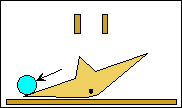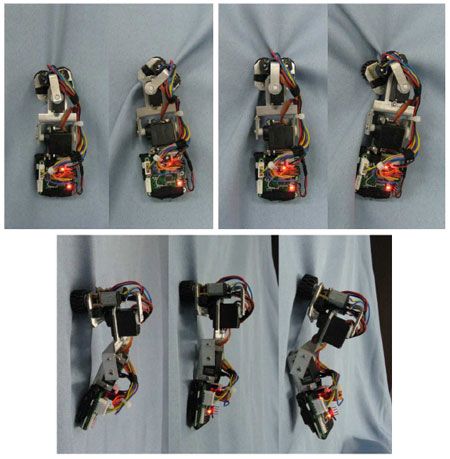I saw a classmate recognize this in class once and he was showing it to our Physics teacher. Hold a piece of paper in your hand on the side like you're grabbing a plate or the side of a tray and curve it using your fingers and thumb on either side of the paper. Then drop something on the other end of the paper. If you orient the paper concave up, the object will be caught inside the scoop shape. If you orient the paper concave down, the object will collapse the arch shape and drop past the paper onto the table.
Concave up....
...catches the object.
Concave down...
...lets the object fall past as the paper bends. Usually the object slides down one of the sides of the arch too, so you'd have to account for that in a practical application.
This reminds me of a flip-flop, valve, or flap, such as the ones seen in sorting machines or marble machines.
You could make this with a material that is a little more stiff and predictable, like rubber or a flexible plastic. The flap could be rotated with a motor or a rotating pneumatic actuator. It could be angled so that when an object gets caught on the concave up side it slides down and away like in a channel.
However, the same actuator that rotates the flap can be used to direct objects much more simply. The two-way action could be done with a stiff, spring loaded flap that is kept from moving one way with a stopper or ledge, like a door jam, and able to freely open in the other direction. So this flap design must be uniquely beneficial for the resources of an actuator to be used up in this way.
One beneficial example I've thought of (which doesn't even require an actuator) is a door into a container that keeps objects from getting out (concave up side faces inside container), but lets objects in (concave down side faces out). This container could be vibrating or tumbling the objects inside, so a one-way opening is needed. The container might be naturally round, like a tire, so this concave flap could be built into its geometry, instead of being an abnormality like a square or circular door.
Search sorting machine on Youtube, or Lego sorting machine.
Related marble machine flip flop:
http://www.sentex.net/~mwandel/marbles/flipflop.html
Thursday, May 17, 2012
Metals that can be molded like plastics
From Makezine.com: http://blog.makezine.com/2012/01/13/metals-that-can-be-molded-like-plastics/
The original article is very good at describing the situation and solution to making metals that are less like hard, orderly crystals and more like grainy, moldable, "amorphous" materials like glass and plastic. The method involves cooling the metal quickly enough so that its molecules don't have enough time to settle down in an orderly configuration and must "freeze" where they are. However, this is practically impossible with pure metals since they have all the same atoms and are extremely orderly to begin with. You can't remove heat fast enough. So alloys are made where the mixture of atoms has a distribution of sizes that do not settle easily.
The first alloy was created in the lab in 1960, from three atoms of silver for each atom of silicon. However, "elaborate means were required to cool the samples fast enough, and they had to be small and thin—wires, ribbons, or foils less than 100 micrometers thick."
In the 1990s, researchers at CalTech made a better alloy with a lower "critical cooling rate."
The original article is very good at describing the situation and solution to making metals that are less like hard, orderly crystals and more like grainy, moldable, "amorphous" materials like glass and plastic. The method involves cooling the metal quickly enough so that its molecules don't have enough time to settle down in an orderly configuration and must "freeze" where they are. However, this is practically impossible with pure metals since they have all the same atoms and are extremely orderly to begin with. You can't remove heat fast enough. So alloys are made where the mixture of atoms has a distribution of sizes that do not settle easily.
The first alloy was created in the lab in 1960, from three atoms of silver for each atom of silicon. However, "elaborate means were required to cool the samples fast enough, and they had to be small and thin—wires, ribbons, or foils less than 100 micrometers thick."
In the 1990s, researchers at CalTech made a better alloy with a lower "critical cooling rate."
The first commercial amorphous metal alloy was brought to market in 2003 by CalTech spin-off Liquidmetal Technologies. Called Vitreloy 1, it’s about 40% zirconium, 20% berylium, and 10% each of titanium, copper, and nickel.Again, read the original article, it has the best information there.
Vitreloy 1 and its successors have a number of exceptional properties. They are strong, hard, and (unlike crystalline metals) they do not shrink appreciably on freezing, and thus can be injection-molded, blow-molded, and otherwise formed using the same economical processes as plastics. Designing tooling for amorphous metals requires paying attention to the critical cooling rate of the material; if some volume of the part cools too slowly, the alloy there will crystallize, shrink, and spoil it.
Labels/Tags:
inspiration
Ranque-Hilsch vortex tube
A tube that separates a neutral temperature stream of compressed air into hot and cold streams, with no moving parts. There are multiple explanations for how it works. Air is fed into the main tube by small tangential inlets, so the gas swirls. After that there are separating-effects at the ends, which have uniquely shaped openings.
This Hack-a-day post shows how to make one, by Otto Belden. Note the efficiency!
"His latest version, which you can see in the video below, takes compressed air at about 78degrees and spits out about 112degrees on the hot side and 8degrees on the cold side."
From Wikipedia:
-----------
The vortex tube, also known as the Ranque-Hilsch vortex tube, is a mechanical device that separates a compressed gasinto hot and cold streams. It has no moving parts.Pressurized gas is injected tangentially into a swirl chamber and accelerated to a high rate of rotation. Due to the conical nozzleat the end of the tube, only the outer shell of the compressed gas is allowed to escape at that end. The remainder of the gas is forced to return in an inner vortex of reduced diameter within the outer vortex.
There are different explanations for the effect and there is debate on which explanation is best or correct.
What is usually agreed upon is that the air in the tube experiences mostly "solid body rotation", which simply means the rotation rate (angular velocity) of the inner gas is the same as that of the outer gas. This is different from what most consider standardvortex behavior — where inner fluid spins at a higher rate than outer fluid. The (mostly) solid body rotation is probably due to the long time which each parcel of air remains in the vortex — allowing friction between the inner parcels and outer parcels to have a notable effect.
It is also usually agreed upon that there is a slight effect of hot air tending to "rise" toward the center, but this effect is negligible — especially if turbulence is kept to a minimum.
One simple explanation is that the outer air is under higher pressure than the inner air (because of centrifugal force). Therefore the temperature of the outer air is higher than that of the inner air.
Another explanation is that as both vortices rotate at the same angular velocity and direction, the inner vortex has lost angular momentum. The decrease of angular momentum is transferred as kinetic energy to the outer vortex, resulting in separated flows of hot and cold gas.[1]
This is somewhat analogous to a Peltier effect device, which uses electrical pressure (voltage) to move heat to one side of a dissimilar metal junction, causing the other side to grow cold.
When used to refrigerate, heat-sinking the whole vortex tube is helpful.
-----------
Labels/Tags:
inspiration
Robot climbs cloth by rolling along a wringle
From IEEE Automation: http://spectrum.ieee.org/automaton/robotics/home-robots/clothbot-has-no-trouble-navigating-your-pants
From the Chinese Academy of Science, called Clothbot. It has two rollers/wheels that pinch the material into a wrinkle, then roll up (or down) this winkle like on a rail. Motors twist the tail/body and the wheels to change direction.
From the Chinese Academy of Science, called Clothbot. It has two rollers/wheels that pinch the material into a wrinkle, then roll up (or down) this winkle like on a rail. Motors twist the tail/body and the wheels to change direction.
Labels/Tags:
inspiration
Subscribe to:
Posts (Atom)










